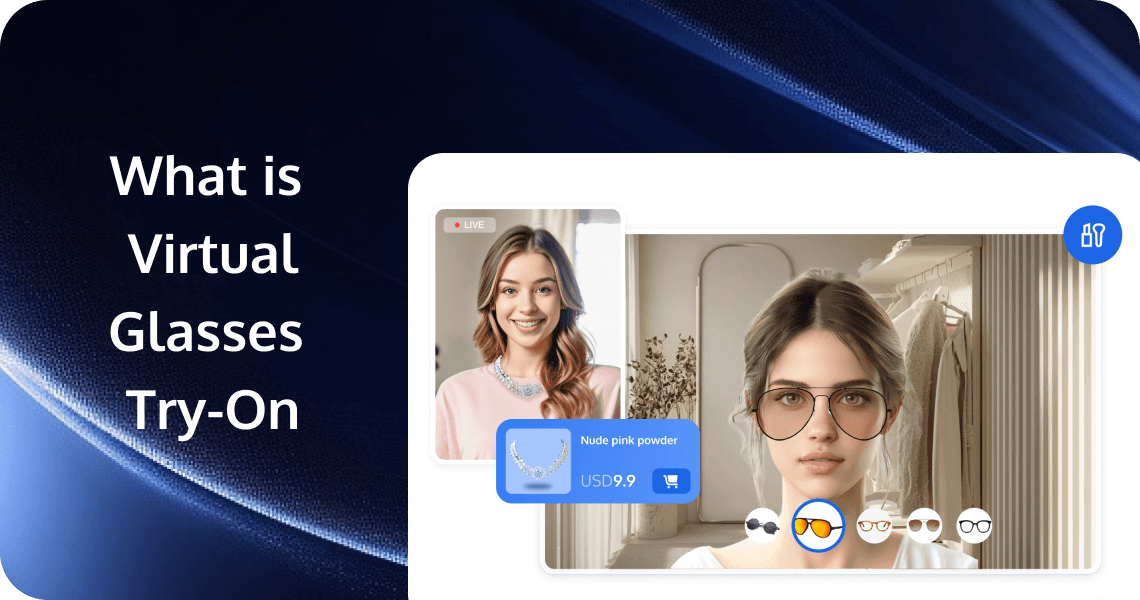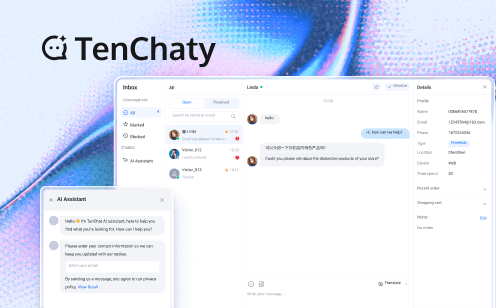
Technology simplifies everyday life. Imagine trying different glasses styles directly on your face without physically being in a store.
The essence of virtual try-on lies in overcoming traditional retail limitations. Whether online or in-store, users can leverage facial recognition and real-time adjustments to find frames that perfectly match their face shape and personal style.
What is Virtual Glasses Try-On?
Virtual glasses try-on is a digital experience driven by advanced imaging algorithms and real-time rendering technology. This innovative solution enables users to instantly try different styles of glasses on their screens, previewing fits and aesthetics without physically interacting with any frames.
Virtual glasses try-ons not only offer a seamless experience but also play a critical role in guiding consumers toward informed choices during the purchasing journey.
By leveraging factors such as face shape, facial features, and skin tone, shoppers can select styles that complement their unique appearance.
This personalized approach benefits both buyers and sellers:
- Enhanced satisfaction: Customers feel confident their purchase aligns with their aesthetics and needs.
- Reduced returns: Precise customization minimizes mismatches, lowering return/exchange rates caused by ill-fitting or unflattering styles.
In essence, virtual try-ons transform a passive shopping experience into an interactive, visually-driven decision-making process.
How Does Virtual Glasses Try-On Work?
Try on glasses seamlessly from your screen—powered by advanced digital fitting technology. Combining precise facial scanning, 3D modeling, and real-time rendering, this solution delivers a frictionless virtual matching experience.
By mapping your unique face shape, adjusting frame dimensions, and simulating optical effects, virtual try-ons don’t just show you how glasses look—they let you feel how they fit. In this part, we’ll demystify the process behind this digital transformation, from capturing your smile to rendering a lifelike preview.
1. Capturing Facial Features
The first step in virtual glasses try-ons is enabling devices to "see" your face. Through a smartphone or AR device’s camera, the system continuously scans your facial area. Algorithms automatically identify key facial landmarks—such as the center of your eyes, the height of your nose bridge, and the shape of your mouth. These points act as anchor points, ensuring subsequent frames align precisely with your eyes. Meanwhile, dynamic tracking technology monitors your head movements in real time (e.g., nodding, tilting) to keep the virtual glasses synced with your body, creating a natural experience akin to wearing physical eyewear.
2. Building a 3D Facial Model
Next, the system generates a three-dimensional "digital face" based on the scanned data. Initially, 3D depth sensing technology (similar to how bats use echolocation) measures facial contours and textures. Algorithms then convert this data into a lifelike 3D model. This process ensures that virtual glasses fit your face shape realistically, rather than appearing in mid-air.
3. Virtual Glasses Adaptation & Rendering
After creating the digital face, the system customizes glasses for you. First, frame dimensions adjust automatically based on your eye spacing and facial width. The temple angles also optimize according to your head shape to prevent slippage. Next, the system simulates realistic optical effects of lenses: sunlight reflections, indoor light transmission, and color transitions in photochromic lenses are calculated with precision. Finally, AR technology superimposes the virtual glasses onto your camera feed (much like adding movie special effects) while handling occlusion—ensuring glasses don’t obscure eyebrows but partially cover eyes for a believable try-on result.
Top 5 Virtual Glasses Try-On Platforms in 2025
Shopping for eyewear has changed dramatically in 2025. No more guessing how frames will look on your face or making multiple trips to stores. Today's virtual try-on technology lets you see exactly how glasses will look on your face—right from your phone or computer.
These new platforms use artificial intelligence to map your facial features and show realistic 3D models of glasses on your face in real time. You can turn your head to see different angles, adjust colors and lens options, and even share images with friends for their opinions.
The best part? You can try dozens of styles in minutes, whenever and wherever it's convenient for you. This technology has made eyewear shopping faster, more enjoyable, and more accurate than ever before.
Let's explore the five best virtual glasses try-on platforms in 2025:
1. SmartBuyGlasses
Technical Advantages:
- Dynamic modeling in real time: Adjust frame dimensions and lens reflection effects based on facial data captured by smartphone cameras
- Intelligent PD calibration: Auto-measure interpupillary distance via micro-expression recognition algorithms with 80% lower error rate
- Luxury brand ecosystem: Integrated optical databases of Ray-Ban, Gucci, etc., enabling virtual coating preview for premium lenses

2. ZenniOptical
Technical Advantages:
- Lightweight photo modeling: Generate 3D facial models from static images, supporting engraving (max 15 chars) and functional lens selection
- Direct supply chain integration: Auto-link to Danyang manufacturing base for 72-hour global shipping
- Zero-learning interface: Intuitive design enabling precise fitting without prescription data
3. LensCrafters
Technical Advantages:
- Omnichannel integration: Sync 2,000+ global store devices for millisecond-level PD calibration
- Asian face optimization: Dedicated algorithms for nose bridge height and orbital depth
- Luxury brand library: Detailed digital replication of Ray-Ban, Versace frames
4. Eyebuydirect
Technical Advantages:
- AI rendering at 0.8s: Convert 2D photos to frame models via Perfect Corp's 3D engine
- Social virality: Generate shareable short-form videos directly from try-on results
- SMB empowerment: Low-code APIs enabling emerging brands to match luxury digital displays
5. VisionExpress
Technical Advantages:
- Cross-channel data fusion: Build visual profiles combining online/offline metrics
- ML-powered recommendations: 92% accuracy in predicting frame style preferences
- Regional customization: Optimized temple curvature for Europe/Asia markets
How to Choose the Right Glasses for Your Face?
Finding the perfect pair of glasses isn’t just about aesthetics—it’s about harmony. Your face shape plays a crucial role in determining which styles flatter your features, enhance your confidence, and suit your lifestyle. Whether you’re opting for bold frames to make a statement or minimalist designs to blend in, understanding how your unique facial structure interacts with different lens shapes can transform your look. In this part, we’ll break down the science (and art) of styling glasses for every face type—from round to oval—so you can skip the trial-and-error and unlock a look that feels truly you.
1. Round Face
Features: Broad forehead, prominent cheekbones, and a chin with similar width. A pronounced double chin may appear when smiling.
Style Tips:
- Opt for horizontal-widened frames (e.g., pilot styles or retro square frames) to balance the roundness.
- Vertical elongation can be achieved with cat-eye lenses or slim metal chains.
- Avoid round frames, as they may accentuate the rounded jawline.
2. Long Face
Features: Face length-to-chin ratio exceeds 1.5:1, with vertically aligned facial features.
Style Tips:
- Choose wide metal frames or those with horizontal decorative strips to break the vertical monotony.
- Bottom-heavy Baroque frames or drooping temple arms can shorten the visual length.
- Pair with warm-toned lenses (e.g., amber) to soften a stern appearance.
- Avoid slim legs or tall nose-bridge designs.
3. Square Face
Features: Prominent jawline and cheekbones with sharp angles.
Style Tips:
- Round frames, oval lenses, or soft material (e.g., acetate) help soften edges.
- Draw attention with colored temples or asymmetric designs.
- Steer clear of sharp rectangular frames or heavy nose pads that highlight the jawline.
4. Heart Face
Features: Broad forehead, high cheekbones, and a pointed chin.
Style Tips:
- Rectangle frames or bottom-accented designs can narrow the chin.
- Frameless glasses or thin metal borders enhance the depth of your eyebrows and eyes.
- Avoid large round frames or wide horizontal temples to prevent emphasizing the pointed chin.
5. Oval Face
Features: Face length ≈ face width, considered the "ideal" proportion.
Style Tips:
- Daily wear: Minimalist solid-color frames.
- Evening outings: Sparkling rhinestone temples or colored lenses for glamour.
- Experiment with engraved metal frames or gradient lenses for subtle details.
- Skip overly bulky or attention-grabbing rivet decorations.
Why Choose Tencent RTC Virtual Try-On Solution?
Tencent RTC offers a sophisticated virtual try-on solution that seamlessly integrates into existing apps and websites. This technology enables users to visualize how eyewear products look on their face in real-time, creating an engaging shopping experience that bridges the gap between online browsing and in-store fitting.
The solution leverages advanced computer vision and augmented reality to provide accurate, realistic renderings that adjust to facial movements and lighting conditions. This precision helps customers make confident purchasing decisions without physically trying on multiple frames.
At the core of Tencent RTC's virtual try-on capabilities is the Beauty AR SDK—a powerful development toolkit designed for creating immersive beauty and fashion experiences. This SDK provides developers with:
- Advanced face tracking with precise facial mapping points
- Realistic rendering of glasses on various face shapes
- Cross-platform compatibility for consistent experiences across devices
Beyond the technical capabilities, the Beauty AR SDK includes additional features such as face quality detection, skin smoothing, virtual makeup, face shaping, background customization, and AR sticker integration—allowing developers to create comprehensive beauty experiences.
Tencent RTC's Virtual Glasses Try-On solution can enhance numerous user experiences:
- E-commerce Platforms: Allow customers to virtually try on glasses before purchasing, reducing return rates and increasing purchase confidence
- Social Media Applications: Enable users to share virtual try-on experiences with friends, creating engaging social shopping moments
- Video Calling and Live Streaming: Incorporate virtual glasses try-on during video interactions for entertainment or shopping assistance
By implementing Tencent RTC's virtual try-on technology, businesses can provide customers with convenient, interactive shopping experiences while gathering valuable data on style preferences and user engagement.
Conclusion
Virtual eyewear try-on technology represents a fundamental shift in how consumers discover, experience, and purchase glasses. By seamlessly integrating real-time rendering technologies with AI-driven personalization, these solutions create an immersive bridge between physical products and digital experiences.
For eyewear retailers and brands, implementing virtual try-on isn't merely following a trend—it's responding to changing consumer expectations and establishing competitive advantage. The technology delivers tangible benefits through increased conversion rates, reduced returns, and deeper customer engagement.
Tencent RTC's Beauty AR SDK provides all the tools businesses need to create compelling virtual eyewear experiences. With precise facial mapping, realistic rendering, and cross-platform compatibility, our solution helps brands transform browsing into buying.
Explore Virtual Try-On Solutions or Contact Us to discuss how we can help implement virtual eyewear try-on for your business.
FAQs About Virtual Glasses Try-On
Q1: How accurate is virtual glasses try-on compared to trying frames in person?
A1: Today's advanced virtual try-on technologies offer remarkably accurate representations of how glasses will look on your face. Using precise 3D facial mapping and product modeling, these systems account for face shape, size proportions, and even how frames sit on different nose bridges. While virtual try-on can't replicate the physical feel of frames, the visual accuracy is typically 90-95% comparable to in-person fitting for most standard frames.
Q2: What technical requirements do customers need to use virtual glasses try-on?
A2: Most virtual try-on solutions work on standard smartphones, tablets, and computers with a camera. For optimal experience, users typically need: a device with a front-facing camera, stable internet connection, and an updated browser or dedicated app. Some advanced features may work better on newer devices, but basic functionality is designed to be accessible on hardware from the past 3-4 years.
Q3: What business benefits can retailers expect from implementing virtual try-on?
A3: Retailers implementing virtual glasses try-on typically report several measurable benefits: 30-40% increases in conversion rates for online purchases, 45-60% reductions in return rates, 3-4x increases in time spent on product pages, and 25-35% larger average order values as customers feel more confident exploring premium options. Additionally, businesses gain valuable data on customer preferences and trying behavior that isn't available through traditional shopping experiences.


